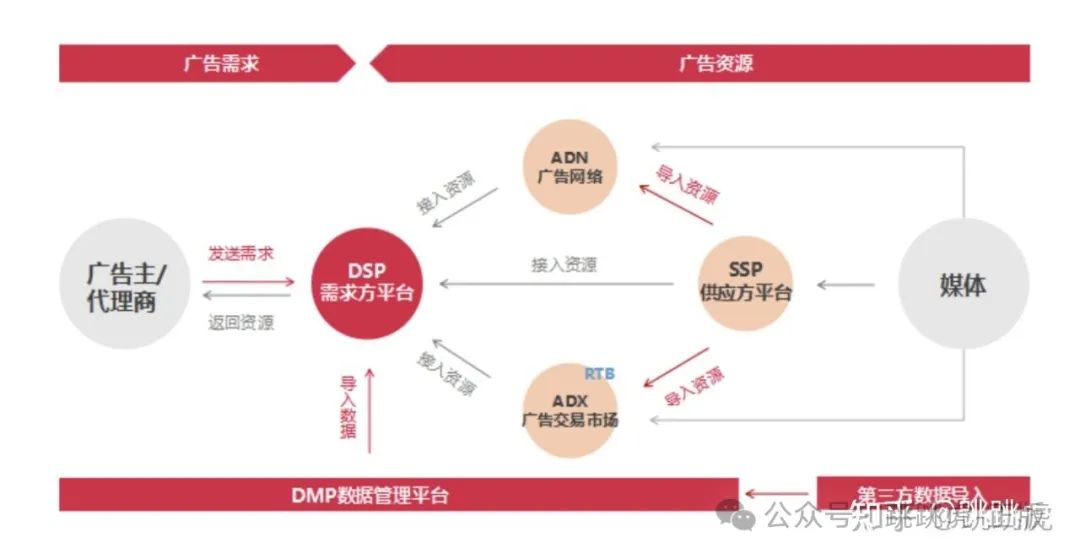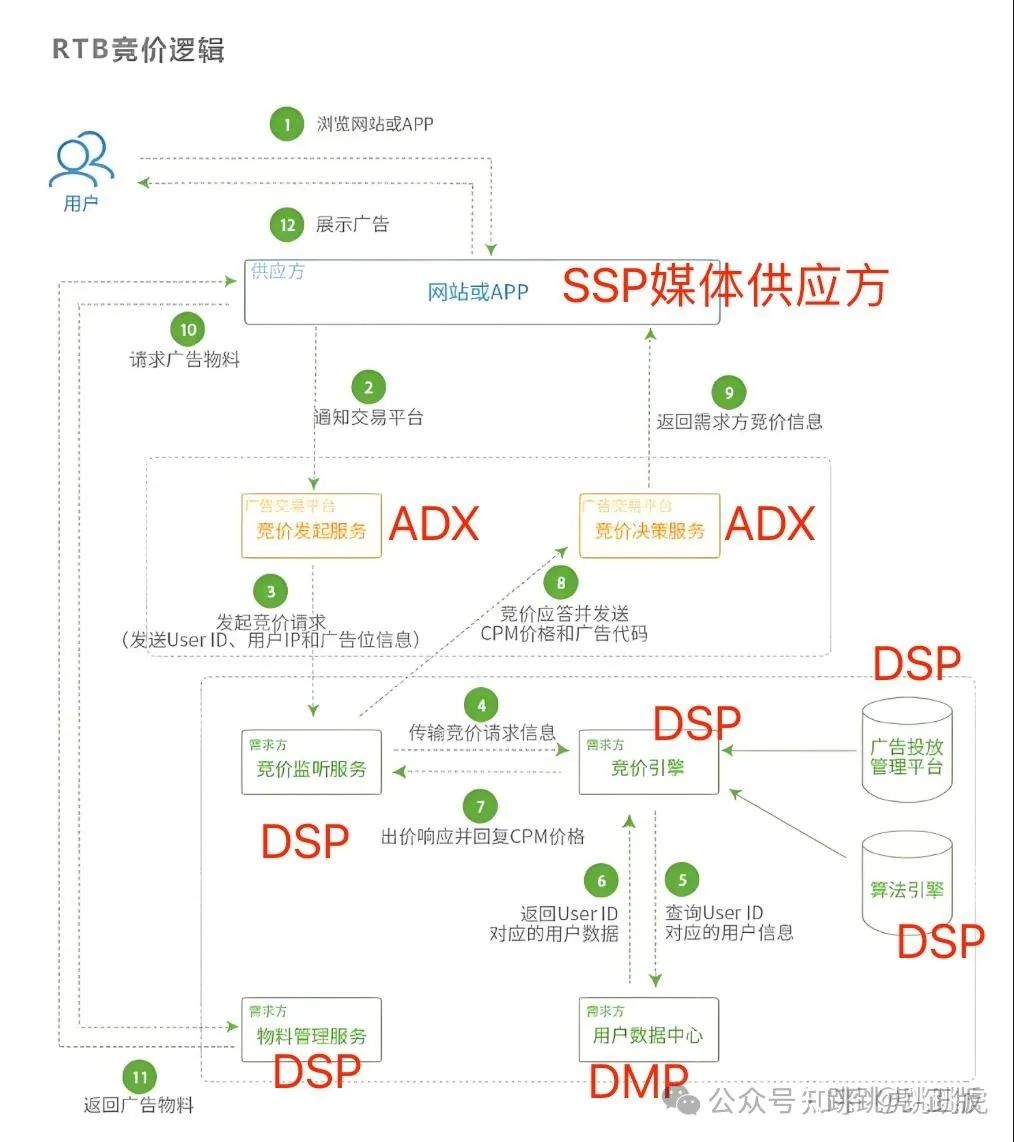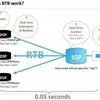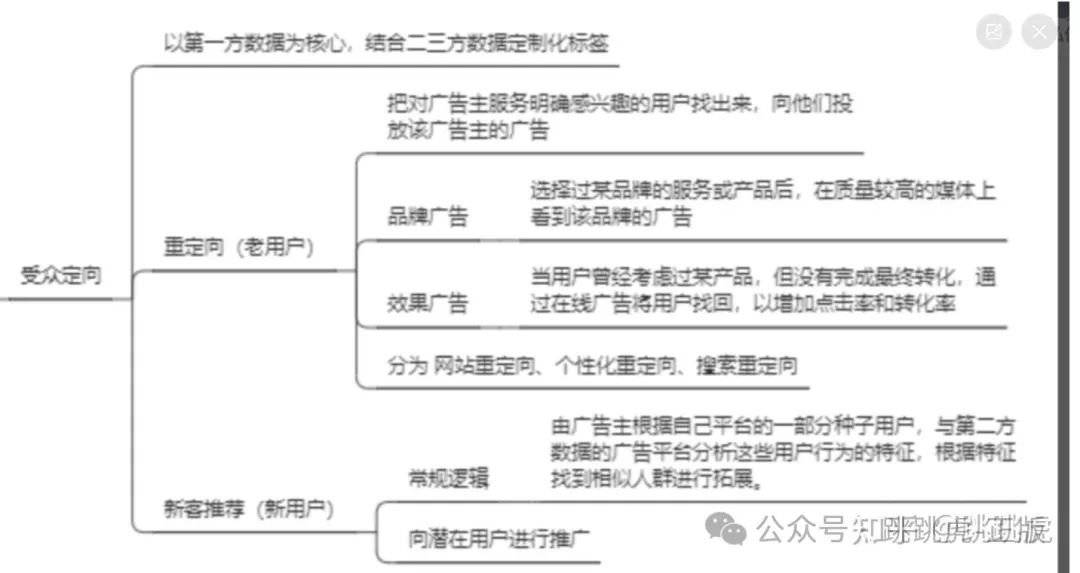DSP (Demand-Side Platform) is an advertising service platform for advertisers, similar to the ad placement interfaces of Google and Facebook. It aggregates a wealth of user historical behavior information (precise user profiles) through a DMP (Data Management Platform) to help demand-side parties (advertisers or agencies) manage Ad Exchange (ADX – an advertising trading market connecting various media resources) through a unified interface. Advertisers can set targeting conditions, budgets, bids, and creatives on the platform, while the DSP automatically optimizes ad delivery effectiveness through technology and algorithms and provides data reports.
Below is my personal understanding; if there are errors, please feel free to point them out:


As shown in the figure, DSP involves cooperation with:
ADX (Advertising Exchange, integrating the advertising demands of advertisers and media buyers, mainly using RTB algorithms for real-time bidding on ads, which can directly connect to advertisers or DSP’s RTB algorithm platforms),
or ADN (Ad Network Alliance Platform – bringing users that can receive ads, can independently connect with clients, or connect to DSP’s RTB algorithm platform),
or SSP (Supply-Side Platform, directly accessing media resources, generally large media with a massive number of users available for ads, which can independently connect with clients or connect to DSP’s RTB algorithm platform).
Additionally, building one’s own DMP platform (user’s basic attributes and various website behavior data, product information, etc., can be purchased from third-party data platforms and will continuously expand when cooperating with advertisers and media parties; the larger the user base, the more convenient it is to retrieve user information from the database in real-time during the connection with SSP media parties and advertiser websites for comparison and algorithm training; helping advertisers locate target users; simply put, the role of DMP is to assist DSP in selecting target users on SSP, generally owned by the DSP platform, and advertisers will also build their own; if needed, the ad data placed by the DSP platform will simultaneously be collected by both the DSP platform’s DMP and the advertiser’s DMP platform).
Qianxun: What are DSP, DMP, ADX, RTB, and RTA?317 Likes · 15 CommentsArticle
In summary, when considering whether a DSP platform is good or not, several aspects should be considered:
How are the media resources connected? What is the RTB bidding capability, and how is the ability to tag users and optimize ad delivery in real-time? How is the training tracking, prediction, and improvement of the ad target user conversion rate’s population database and algorithm model?
1. How are the media resources?
A vast array of media resources directly determines the coverage range of advertisers’ placements, while the quality of media resources determines the quality of users and the efficiency of ad placements. An ideal DSP platform should have full traffic, full coverage, and full purchasing, specifically reflected in:
1) Resource channels connected: It is best if it can connect to different ADX advertising trading platforms, ADN ad networks, and directly to media-connected SSPs;
2) Types of media resources connected: It is best if it can cover various types of media resources such as portals, SNS, video platforms, vertical websites, mobile applications, etc.; the quality of connected media resources should ideally include high-quality, large-volume, top-ranked media resources in addition to the long-tail media commonly found on advertising trading platforms;
3) Full-screen coverage: Support cross-device placements, including cross-PC, mobile devices, smart TVs, etc., ensuring that ad delivery can cover users’ multi-screen usage scenarios;
2. What is the RTB bidding capability, and how is the ability to tag users and optimize ad delivery in real-time?
1) DSP’s bidding capability: This is one of the core capabilities of a DSP advertising platform;
RTB bidding capability: Whether the DSP platform has independently developed RTB bidding algorithms affects whether the DSP can participate in bidding for ad slots at the moment users browse web pages or use applications, ensuring the immediacy and accuracy of ad displays, maximizing the chances for advertisers to win quality ad slots and helping the platform earn more ad revenue. Can it perform effect estimates before bidding and optimize in real-time during bidding?
Understanding what Ad Network, Ad Exchange, DSP, SSP, RTB, and DMP are:www.163.com/dy/article/CM49794D0520A6C0.html
2) DSP’s capabilities in tagging and optimization:
——Tagging (mainly implemented on DMP): This relates to what dimensions of tags the DSP platform uses to accurately find target users, such as whether it can achieve precise user profiling through data from the media side, advertiser website side, and the platform’s accumulated data, supporting multi-dimensional targeting based on interests, behaviors, geographical locations, etc. Can it be refined down to product models, brands, years, etc.? Does it support similar audience expansion? Can it control frequency and device recognition uniformly across different channels and devices?

——Algorithm optimization: Can it use machine learning algorithms to continuously optimize ad delivery strategies, improve ad conversion efficiency, and achieve smarter audience matching? Specifically, how many optimization dimensions does the platform support? Does it support dynamic ad carousel optimization for uploaded product catalogs (similar to personalized content technology)? Can it optimize in real-time during ad delivery?
3. How is the training tracking, prediction, and improvement of the ad target user conversion rate’s population database and algorithm model?
1) The larger the DSP’s population database, the higher the quality of users, and the more precise the algorithm model, the higher the accuracy of finding target users, predicting target users’ next behaviors, and improving user ad conversion rates: Therefore, it is important to see whether the DSP platform has enough advertiser and media cooperation project case studies. The more cases there are, the more user data the DSP platform accumulates, and the more data the algorithm model has to be trained and optimized;
2) Specific data collection dimensions (these data will be uniformly collected to the DMP platform):
——Media-side data (collected through the DSP platform’s SDK or server integration): Can continuously monitor a large amount of user basic attributes and behavior data on media 24/7;
——Advertiser website-side data (collected through the DSP platform’s SDK or server integration): Can accumulate user basic attributes, consumption time, behavior, product, and other dimensional data on the advertiser’s website platform year-round (the SDKs on the advertiser’s website side and media side are different, but user data is unified through user device identification numbers or user IDs);
——Cross-device and cross-media data: Can identify users and unify various data across different media and devices through device identification numbers or user IDs (website side is cookies);
——Delivery data (acquired on the proprietary DSP platform): Can be collected massively across various industries 24/7;
In summary:
——In breadth, a quality DSP can collect massive data across channels, platforms, and media, achieving a core data volume in the trillions;
——In depth, the granularity of data analysis is sufficient to segment the population from various dimensions such as time, behavior, and products, achieving precise targeting of audience and realizing a win-win situation for improving advertisers’ ROI and the DSP platform’s commercial revenue.
4. Conclusion:
I have previously cooperated with excellent DSP teams, and they all possess the following characteristics:
1) Have a professional execution and support team (such as creative, customer service, etc.);
2) Have a clear understanding of advertisers’ brands and marketing goals and can provide professional placement advice;
3) Have a clear understanding of frontend creativity, services, backend data models, algorithms, and can provide comprehensive services from media to advertising;
4) Have rich advertising placement experience across different industries and multiple projects, which provides a more comprehensive and targeted understanding of different industries;
How to choose the right DSP advertising platform? – Banban’s article – Zhihu
Banban: How to choose the right DSP advertising platform?
Above, I hope it helps!